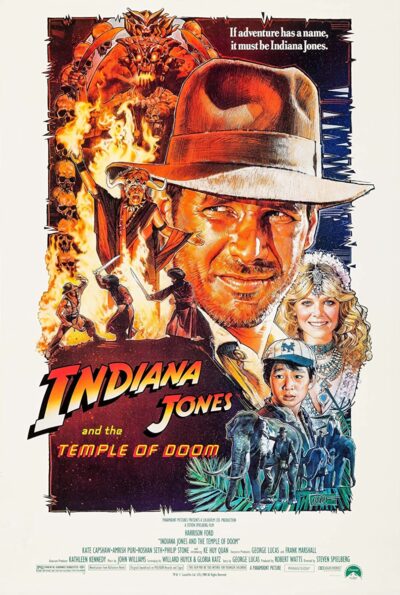 I’ve long held that Steven Spielberg’s most interesting films are his failures, most notably THE SUGARLAND EXPRESS (1974), 1941 (1979), EMPIRE OF THE SUN (1987) and A.I.: ARTIFICAL INTELLIGENCE (2001). It may be wrong to include INDIANA JONES AND THE TEMPLE OF DOOM (1984) in that lineup, as it was a sizeable hit, but it’s a movie Spielberg and executive producer George Lucas have expressed regret for making, with Spielberg claiming INDIANA JONES AND THE LAST CRUSADE (1989) exists to “apologize” for TEMPLE OF DOOM.
I’ve long held that Steven Spielberg’s most interesting films are his failures, most notably THE SUGARLAND EXPRESS (1974), 1941 (1979), EMPIRE OF THE SUN (1987) and A.I.: ARTIFICAL INTELLIGENCE (2001). It may be wrong to include INDIANA JONES AND THE TEMPLE OF DOOM (1984) in that lineup, as it was a sizeable hit, but it’s a movie Spielberg and executive producer George Lucas have expressed regret for making, with Spielberg claiming INDIANA JONES AND THE LAST CRUSADE (1989) exists to “apologize” for TEMPLE OF DOOM.
It was of course the first of four sequels to the mega-hit RAIDERS OF THE LOST ARK (1981)—a prequel, actually, as it was set in 1935, a year prior to RAIDERS’ timeframe—and a contentious one. Its violence quotient caused an outcry back in ‘84, and led to the creation of the PG-13 rating (a certification that falls between a PG and an R that has become Hollywood’s rating of choice) by the MPAA. The onscreen mayhem came about, Lucas and Spielberg claim, due to the upheavals in their private lives, with Lucas undergoing a costly divorce and Spielberg caught up in the hubbub surrounding the deaths of actor Vic Morrow and two children on the set of TWILIGHT ZONE: THE MOVIE (1983). Some commentators have even gone so far as to opine that the Sri Lanka lensed INDIANA JONES AND THE TEMPLE OF DOOM’s primary reason for existence was to get Spielberg and co-executive producer Frank Marshall (both of whom produced TWILIGHT ZONE: THE MOVIE) as far away from the United States as possible during the TWILIGHT ZONE criminal trial.
Violent? In TEMPLE OF DOOM’s first ten minutes Indiana Jones (Harrison Ford), in a Shanghai nightclub to steal a valuable diamond, threatens an American singer named Willie (Kate Capshaw, the future Mrs. Steven Spielberg) by poking her with a fork, impales a Chinese man with a skewer, sees a Chinese companion gunned down and initiates a mass shoot-out. He escapes with the help of his kid sidekick Short Round (future Oscar winner Ke Huy Quan), with Willie accompanying Indy and Shorty on an airplane (even though it’s already been established that she and Indy hate each other) owned by Indy’s nemesis Lao Che (Roy Chiao). The latter’s henchmen pilots, rather than executing their captives, elect to dump the plane’s fuel in midair and parachute out, forcing Indy, Shorty and Willie to escape the plane in a self-inflating raft that deposits them in a river in India. Needless to say, anyone desiring plausibility, even by the lax standards of an Indiana Jones movie, will be left bereft.
Anyway: the trio happen upon a village devastated by the theft of a magical Sankara stone by a Thuggee cult, who also snatched the villager’s children. Indy, hoping for some fortune and glory, heads with his companions to a nearby palace where, after a banquet whose delicacies include live eels, eyeball soup and chilled monkey brains, he discovers a subterranean cavern accessible by pressing the breasts of a lady statue. In this underworld a freak named Mola Ram (Bollywood legend Amrish Puri) has enslaved the missing children, forcing them to mine for more magic stones while he plucks a man’s heart out of his chest and then lowers the unfortunate fellow into a lava pit.
At this point the film essentially turns into a vast experiment, with the object being to maintain peak periods of excitement for as long as possible. In this endeavor Spielberg appears to have had MAD MAX 2/THE ROAD WARRIOR (1981) in mind, down to the climactic mine car chase on rollercoaster tracks that, in common with the lengthy action set-piece that concluded MAD MAX 2, was heavily inspired by the locomotive chase in THE GENERAL (1926).
Questionable though his motives may have been, this is some of the finest action moviemaking Steven Spielberg has ever done, being easy to follow and featuring superbly integrated stunt work. What gets sacrificed, alas, is narrative structure (the movie essentially has two acts: outside the Temple of Doom and inside), several supporting characters (such as Captain Blumburtt, played by THE SHINING’s Philip Stone, who’s introduced early on only to sit most of the rest of the film out), continuity (with close-ups and wide shots, such as those on the rope bridge set climax, often failing to match up) and tone (with the comedic undertones of RAIDERS OF THE LOST ARK allowed to run riot).
Then there’s the violent content. It’s been opined that all the brutality and killing seen here were Spielberg giving vent to his psychological upset over the TWILIGHT ZONE accident, resulting in images of abused children amid a swirl of beating, crushing, burning, shooting and strangulation.
It’s that psychological resonance that, more than anything else, makes this ludicrous and misconceived film a worthwhile watch. The action may not be as well sustained as Spielberg intended, but attains a level of intensity that, combined with the heightened brutality, bespeaks a sense of personal engagement that isn’t present in any of the other INDIANA JONES movies.
Vital Statistics
INDIANA JONES AND THE TEMPLE OF DOOM
Paramount Pictures
Director: Steven Spielberg
Producer: Robert Watts
Screenplay: Willard Huyck, Gloria Katz
Cinematography: Douglas Slocombe
Editing: Michael Kahn
Cast: Harrison Ford, Kate Capshaw, Ke Huy Quan, Amrish Puri, Rushan Seth, Philip Stone, Roy Chiao, David Yip, Ric Young, Kua Kah Joo, Rex Ngui, Philip Tann, Dan Aykroyd, Akio Mitamura, Michael Yama, D.R. Nanayakkara, Dharmadasa Kuruppu, Stany De Silva
